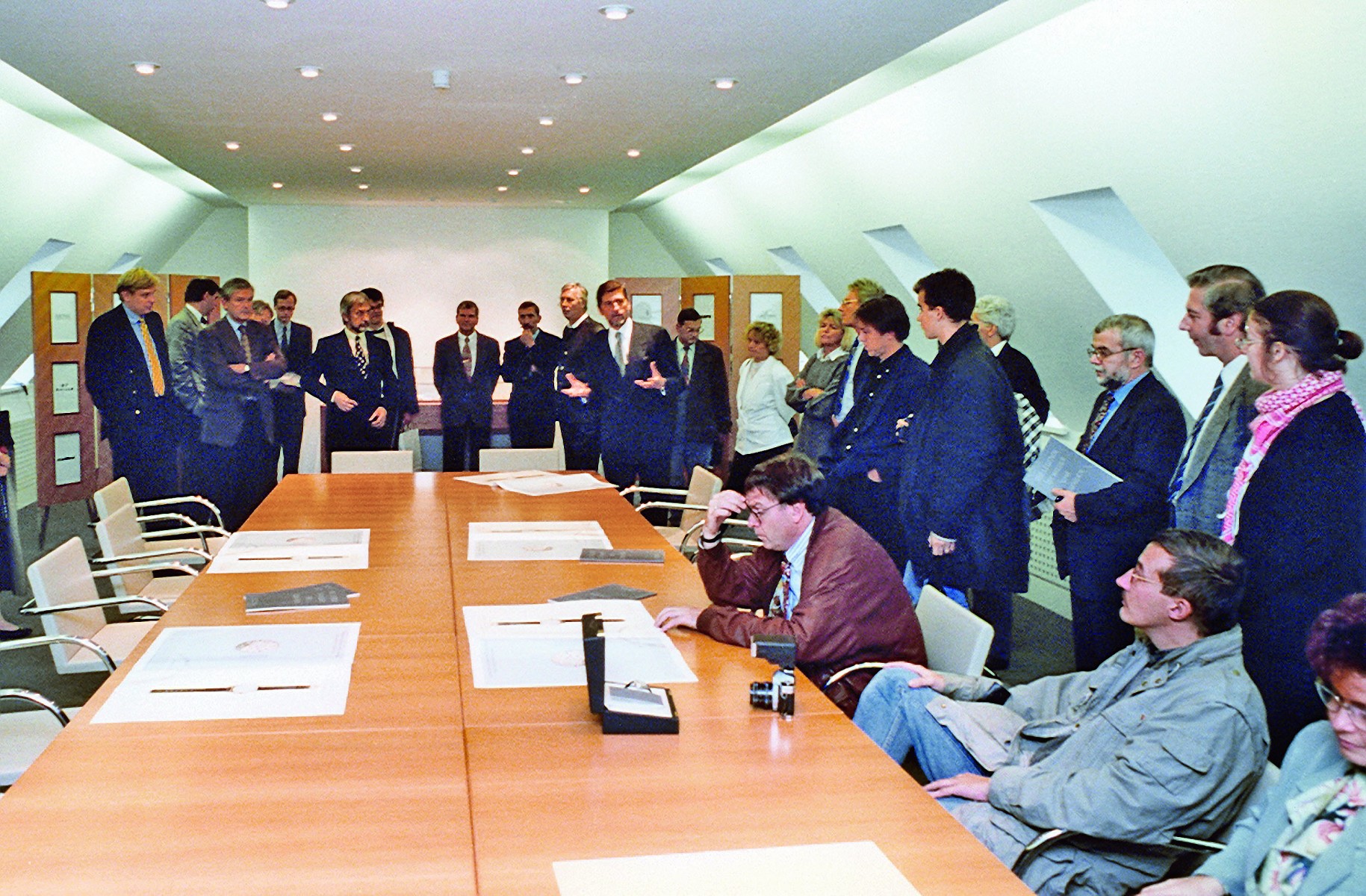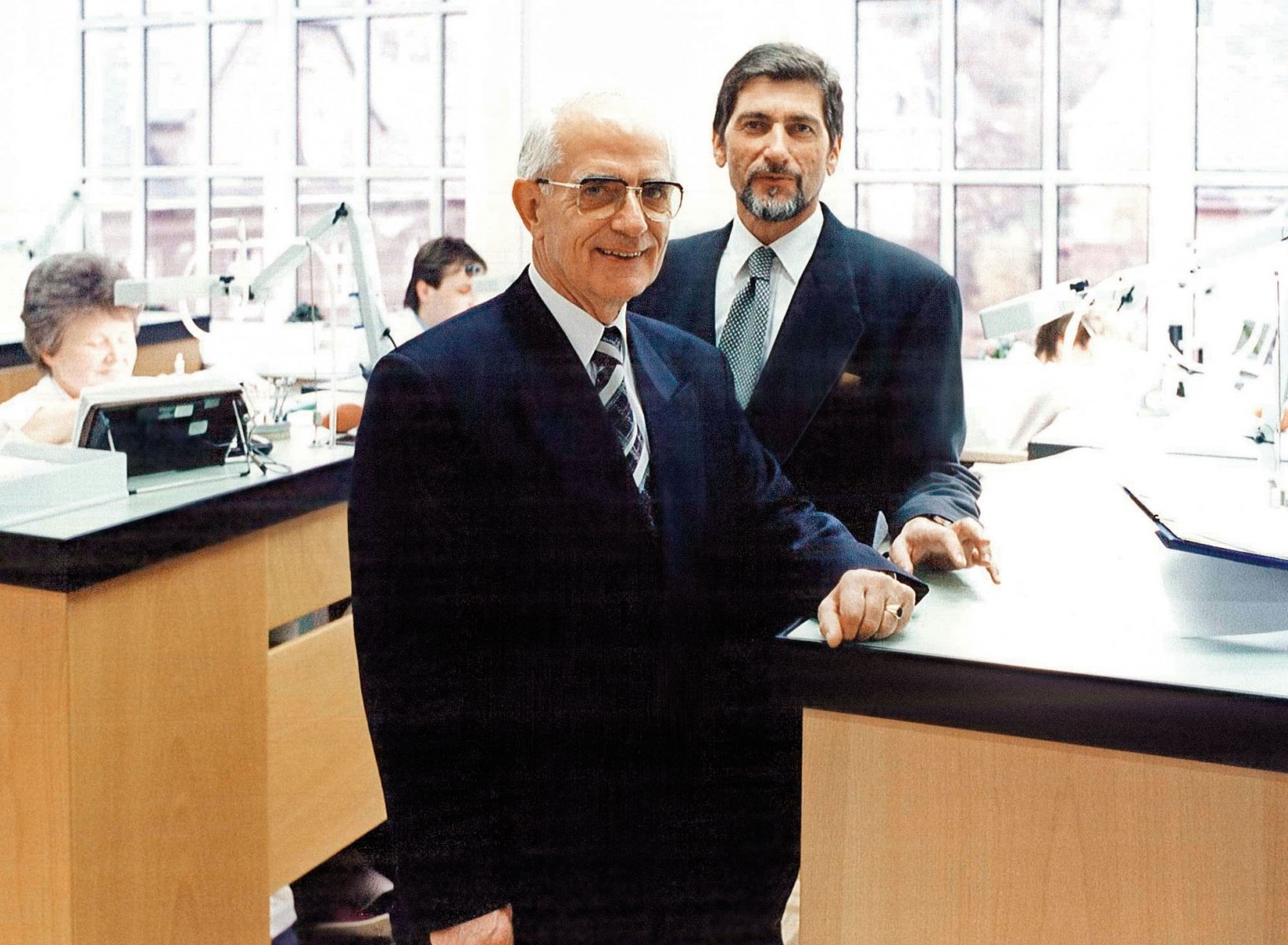An unforgotten legend
A. Lange & Söhne pays tribute to Günter Blümlein
1 October 2001 marks 20 years since Günter Blümlein died at the age of just 58. On his untimely death, A. Lange & Söhne lost its visionary co-founder and the world lost a charismatic businessman and strategist, who played a crucial role in driving the renaissance of the watchmaking industry in the late 20th century.
It takes a whole team of highly motivated employees to develop and manufacture an extraordinary timepiece – but it also takes someone who firmly believes in the underlying idea, champions it and drives the project forward. Günter Blümlein knew how to lead with visions. One of his greatest accomplishments was reviving the brand A. Lange & Söhne with Walter Lange, starting with next to nothing. He had already successfully repositioned two other Swiss watch brands, IWC and Jaeger-LeCoultre.
Günter Blümlein studied precision engineering and was also a marketing expert. He is rightly considered to have helped save the Swiss watchmaking industry after the quartz crisis of the 1970s and to have played a major role in reviving Glashütte precision watchmaking following Germany’s reunification. Walter Lange, re-founder of A. Lange & Söhne and great-grandson of Ferdinand Adolph Lange, once said in his usual direct style: “Without Günter Blümlein, A. Lange & Söhne would not exist any more – and Glashütte would not have resumed its role as the centre of German precision watchmaking.”
Unlike many other industry players, Günter Blümlein did not have any direct links to watchmaking. Born in 1943, his childhood and youth were dominated by Germany’s Wirtschaftswunder, or economic miracle. Following its destruction in the war, his home town of Nuremberg experienced a sharp upturn when well-known industrial firms settled there during this period. This may have contributed to his decision to study engineering. His career took him to the Black Forest to work for the Diehl Group, which had taken over the watchmaker Junghans in the 1950s. Here, he gained an outstanding reputation as Director of Marketing and Sales.
He also put his extraordinary talent to use in his next position, when he was given the task of repositioning the watch brands IWC and Jaeger-LeCoultre, which VDO (later a Mannesmann subsidiary) had brought together in a holding company called Les Manufactures Horlogères (LMH). Like many other Swiss brands, the two watchmakers had suffered in the quartz crisis.
However, the project closest to Günter Blümlein’s heart was reviving A. Lange & Söhne in close collaboration with Walter Lange. Following an involuntary hiatus of over forty years, what was needed was a completely new concept for a brand which had once been famous for top-quality pocket watches. By 1990, however, it was little more than a myth. Blümlein decided to start with the position that Lange already occupied when it came up at auctions – at the very top of precision watchmaking. The idea was that the former Glashütte pocket watches would serve as the basis of a strong brand and product philosophy founded on artisanal craftsmanship. In line with the ethos of Ferdinand Adolph Lange, founder of the Saxony-based precision watchmaking workshop, the new wristwatches were to combine useful innovations with perfect craftsmanship and thereby forge a link between tradition and modernity.
“A Lange watch is a complete work of art. It combines the watchmaker’s passion for mechanisms and craftsmanship with the inimitable style of the brand and its rich history,” said Blümlein, summarising his conceptual approach. He was well aware of just how fine the line was between triumph and defeat: “As a newcomer, we cannot afford the slightest weakness. Our products must be perfect, down to the tiniest detail,” he said after the inaugural press conference on 24 October 1994. The specialist retailers, journalists and guests of honour who attended the event agreed that first four Lange wristwatches of the new era by no means fell short of this standard. All of the 123 watches that had been manufactured up to that point sold out within a matter of minutes.
Several of Blümlein’s strategic product decisions became mainstays of the new company. Four models illustrated these in exemplary fashion. Featuring an off-centre dial, a twin mainspring barrel and an outsize date – the first regularly produced wristwatch to do so – the LANGE 1 was the new face of the brand. The campaign co-designed by Blümlein communicated its advantages in a witty, confident style. “When time came home” became a famous catchphrase.
With its combination of a one-minute tourbillon and a fusée-and-chain mechanism, the TOURBILLON “Pour le Mérite” proved that Lange was qualified to re-enter the league of haute horlogerie right from the start. Never before had a mechanism of this kind been realised in wristwatch dimensions.
The DATOGRAPH made quite a sensation at Baselworld 1999. After decades of standard chronograph movements being used even by renowned manufactories, the “newcomer” Lange had developed a unique, proprietary chronograph movement featuring technical refinements such as a precisely jumping minute counter for up to 30 minutes and the Lange outsize date.
The brand then went two steps further with the DOUBLE SPLIT, whose presentation Günter Blümlein unfortunately did not live to see. This timepiece was not just the first split-seconds chronograph which enabled intermediate and comparative times of up to 30 minutes: it was also the first watch to contain a balance spring developed and manufactured in house. This expertise guaranteed the greatest possible freedom in the development of new movements. It was one of many forward-looking decisions made by Blümlein which still benefit A. Lange & Söhne today.
Günter Blümlein was not one to compromise on design either. Clear and balanced, with strong references to value, he and his team worked tirelessly to hone the design of new models, striking case shapes and an aesthetic movement architecture. The results are so convincing that many watch experts believe Lange timepieces can be identified reliably even without a logo.
By reviving traditional finishing techniques, using solid precious metals and employing the German silver associated with historic pocket watches for all frame parts, the founders of Lange demonstrated beyond doubt that considerations such as exclusivity, durability and value had been taken into account in every aspect of the timepiece.
In an interview, Walter Lange recalled that: “Günter Blümlein was well respected as one of a kind within the industry because he was both a realist and a visionary. He had a virtually unrivalled gift for convincing the people who worked with him of his ambitious goals and inspiring them to pursue the same aims.” His vision and his ability to inspire have outlived him – as have his quest for absolute precision, his feel for form and quality, his ability to see the big picture, and his appreciation of fine differences. To this day, they are embedded in every timepiece that leaves the manufactory.








